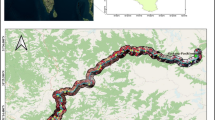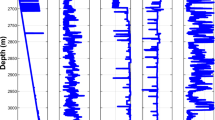Abstract
In order to prevent water inrush from working face floor, it is an urgent problem to predict destroyed floor depth. In this paper, based on the collected samples of floor failure depth of north China type coal fields, the factors that influence the development of floor failure depth were obtained by principal component analysis(PCA), that is, mine pressure, working face information, tectonic conditions, lithology, and sedimentary conditions of coal seam. Then, the parameters of support vector regression (SVR) were optimized by genetic algorithm (GA), the PCA-GA-SVR prediction model of floor failure depth was established, we put the last 4 samples into the model and verified its excellent generalization ability. Finally, we applied the PCA-GA-SVR model to the floor failure depth prediction of Zhaizhen coal mine, comparing the predicted value of the model with the field measured value using double side seal borehole water injection device, the effectiveness of the model was demonstrated.








Similar content being viewed by others
References
Chang J, Qiu H, Ye Y (2013) Research on wave-field transformation and data processing of mine transient electromagnetic method. J China Coal Soc 38(9):1646–1650 (in Chinese)
Gao W, Shi L, Han J, Zhai P (2018) Dynamic monitoring of water in a working face floor using 2D electrical resistivity tomography (ERT). Mine Water Environ 37(3):423–430. https://doi.org/10.1007/s10230-017-0483-z
Gao W, Shi L, Zhai P (2019) Water detection within the working face of an underground coal mine using 3D electric resistivity tomography (ERT). J Environ Eng Geophys 24(3):497–505. https://doi.org/10.2113/JEEG24.3.497
Howard KWF, Howard KK (2016) The new “silk road economic belt” as a threat to the sustainable management of Central Asia’s transboundary water resources. Environ Earth Sci 75:976. https://doi.org/10.1007/s12665-016-5752-9
Hu W, Zhu K, Huang M (2010) Study on floor rock mass failure and water inrush caused by non-uniform distributed water pressure in mining face. J China Coal Soc 35(7):1109–1114 (in Chinese)
Li J (2011) Study on parameter optimization of support vector machine. Mas. thesis, Huazhong University of Science and Technology, Wuhan, China, pp 27–30
Li L, Wen G, Wang R (2008) Parameter selection method of support vector regressive based on genetic algorithms. Comput Eng Appl 44(7):23–26 (in Chinese)
Li J, Zhang L, Tang T (2013a) Data acquisition algorithms based on GA-SVR. J Guilin Univ Electron Technol 33(5):379–383 (in Chinese)
Li P, Qian H, Wu J, Zhang Y, Zhang H (2013b) Major ion chemistry of shallow groundwater in the dongsheng coalfield, Ordos basin, China. Mine Water Environ 32(3):195–206. https://doi.org/10.1007/s10230-013-0234-8
Li J, Xu Y, Xie X (2015a) Influence of mining height on coal seam floor failure depth. J China Coal Soc 40(supplement):1109–1114 (in Chinese)
Li P, Qian H, Howard K, Wu J (2015b) Building a new and sustainable “silk road economic belt”. Environ Earth Sci 74(10):7267–7270. https://doi.org/10.1007/s12665-015-4739-2
Li P, Qian H, Zhou W (2017) Finding harmony between the environment and humanity: an introduction to the thematic issue of the Silk road. Environ Earth Sci 76(3):105. https://doi.org/10.1007/s12665-017-6428-9
Liu S, Li Y (2007) Study on parameter selection of adaptive GA-SVM. J Harbin Eng Univ 28(4):398–402 (in Chinese)
Liu B, Liang B (2011) Prediction of seam floor water inrush based on combining principal component analysis and support vector regression. Coal Geol Explor 39(1):29–35 (in Chinese)
Liu Z, Jin D, Liu Q (2009) Prediction of water inrush through coal floor based on binary logistic regression model and CART. Coal Geol Explor 7(1):56–61 (in Chinese)
Lucas L, Jauzein M (2008) Use of principal component analysis to profile temporal and spatial variations of chlorinated solvent concentration in groundwater. Environ Pollut 151:205–212. https://doi.org/10.1016/j.envpol.2007.01.054
National Coal Industrial Bureau (2008) Rules for coalmining relating to building, water body railway and main tunnel. China Coal Industry Publishing House, Beijing, pp 19–23
Shi L, Han J (2004) Floor water inrush mechanism and prediction. China University of Mining and Technology Press, Xuzhou, pp 3–10 (in Chinese)
Shi L, Gao W, Han J, Tan X (2017) A nonlinear risk evaluation method for water inrush through the seam floor. Mine Water Environ 36(4):597–605. https://doi.org/10.1007/s10230-017-0449-1
Wu J, Yang S, Liu C (2009) Support vector machine short-term load forecasting method based on GA optimizing parameters. J Central South Univ (Nat Sci Ed) 40(1):180–184 (in Chinese)
Yin H, Lefticariu L, Wei J (2016) A multi-method approach for estimating the failure depth of coal seam floor in a longwall coal mine in China. Geotech Geol Eng 34:1267–1281 (in Chinese)
Yu X (2011) Study on broken depth of damage floor. Ph.D. thesis, Shandong University Science and Technology, Qingdao, China, pp 13–17
Zhang J, Shen B (2004) Coal mining under aquifers in China: a case study. Int J Rock Mech Min Sci 41(4):629–639. https://doi.org/10.1016/j.ijrmms.2003.01.005
Zhang R, Jiang Z, Li X (2013) Study on the failure depth of thick seam floor in deep mining. J China Coal Soc 38(1):67–72 (in Chinese)
Zhang P, Yan W, Zhang W (2016) Mechanism of water inrush due to damage of floor and fault activation induced by mining coal seam with fault defects under fluid-solid coupling mode. Chin J Geotech Eng 38(5):877–889 (in Chinese)
Acknowledgements
The authors gratefully acknowledge the editors and anonymous reviewers that substantially improved the manuscript. The work of the author was supported by the National Science Foundation (41807283, 41572244, 51804184), and Scientific Research Foundation of Shandong University of Science and Technology for Recruited Talent (2019RCJJ024). ‘Outstanding Youth Innovation Team Support Plan’ of colleges and universities in Shandong Province (2019KJG007).
Author information
Authors and Affiliations
Corresponding author
Additional information
Publisher's Note
Springer Nature remains neutral with regard to jurisdictional claims in published maps and institutional affiliations.
Rights and permissions
About this article
Cite this article
Gao, W., Han, J. Prediction of Destroyed Floor Depth Based on Principal Component Analysis (PCA)-Genetic Algorithm (GA)-Support Vector Regression (SVR). Geotech Geol Eng 38, 3481–3491 (2020). https://doi.org/10.1007/s10706-020-01227-3
Received:
Accepted:
Published:
Issue Date:
DOI: https://doi.org/10.1007/s10706-020-01227-3




